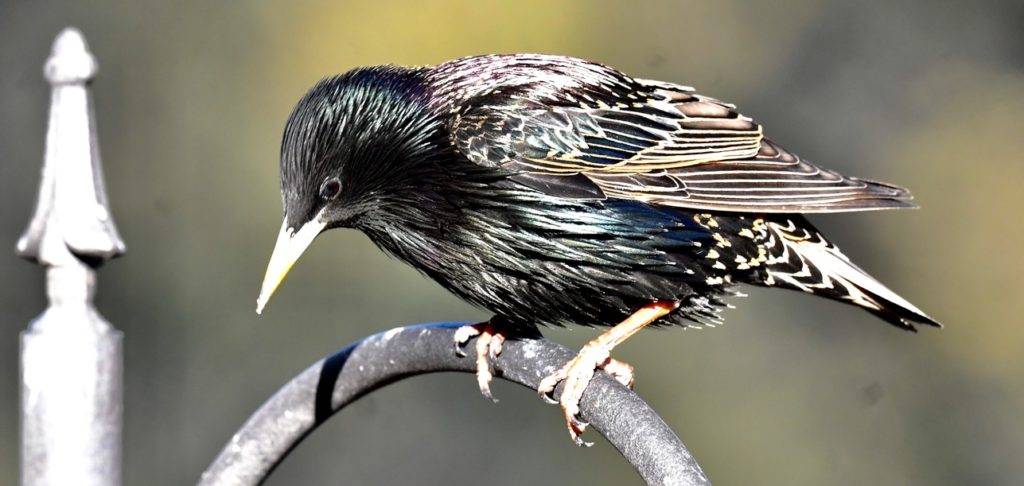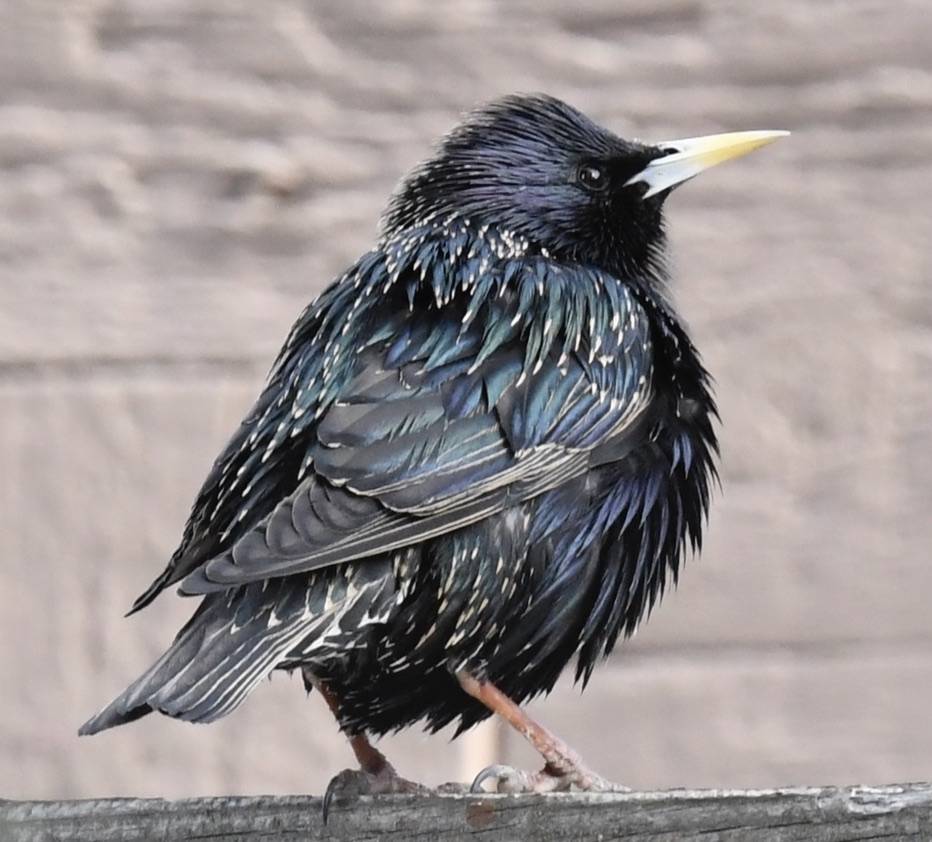(Sturnus vulgaris)
By Sevilla Rhoads

The most fervently despised species in the U.S. descended from eighty birds brought to this country from England because they are mentioned in Shakespeare’s Henry IV. Named for its plumage, which evokes a sense of stars shining in a night sky, this bird’s luminous shimmer hints of the aurora borealis in its startling beauty. So intelligent, cute, and musical that Mozart kept one as a beloved pet, Sunriver is cursed and blessed by our resident European Starlings.
Mozart cared so deeply for his Starling that, even though he did not attend his own father’s memorial, he gave his Starling a formal funeral and wrote it a touching elegy. Mozart found his Starling in 1794 when he heard a bird singing a variation of the motif for his Concerto No. 17 in G major. He followed the sound into a pet store where he came upon and promptly bought the young Starling singing his music. In his expense book, under the entry for the amount he paid for the bird, he wrote out the Starling’s version of the motif alongside his composition, stating (in German) about the Starling’s interpretation: “That was wonderful!”
Since this Starling then lived with Mozart for at least three years while Mozart composed three symphonies, eight piano concertos, and The Marriage of Figaro, it is fun to imagine a Starling working to help Mozart’ improve’ his music! There is an unsolved mystery regarding Mozart’s Starling because the motif it sang from the pet store was top secret at the time. Mozart, paranoid about someone stealing his ideas, had confidentially sent only one copy of the score to this father for review. If you are curious to learn more, I recommend Lyanda Haupt’s book: Mozart’s Starling.
Just this tiny bit of Starling trivia causes me to look twice at Sunriver’s Starlings, which I admit I used to ignore. Partly I ignored them because they are brushed off as ugly and nasty pests by almost all Americans, including conservationists, city folk, country folk, farmers, and well, just about anyone in the U.S. However, to be honest, I also tried not to think about Starlings because they bring up such complicated and challenging questions and issues. Stealing from Disney’s Encanto, the birders’ version of the Bruno song could easily be: “Don’t talk about Starlings!”
The European Starling was brought here through no fault of its own and has done its best to survive the constant attempts by governments and private citizens alike to eradicate it. In the face of systemic persecution, the Starling, a champion of survival, has managed to thrive and spread across the entire country with a current population of around two hundred million. Sadly, while a model of evolutionary success, the Starling lifestyle comes at a high cost to the U.S.
Among the list of problems caused by Starlings are an estimated eight hundred million dollars worth of annual agricultural damage, deadly plane crashes (killing over sixty people in one), pollution from masses of their droppings, and they compete with native birds for food and nesting cavities. Studies debate whether there is sufficient evidence that Starlings ultimately harm native population numbers. Still, there is no doubt they take food and shelter which would otherwise be available for struggling native species.
Genetic tests indicate all the Starlings in the U.S. came from the eighty birds released in Central Park in 1890 by a deputy in an Acclimatization Society. This deputy, allegedly to help people feel less homesick for Europe, decided he would bring every bird mentioned by Shakespeare to America. A large sum was paid to have the Starlings carefully transported from England and released in Central Park.
Why did Shakespeare include a Starling in Henry VI? Starlings, rivaled only by parrots in this skill set among bird species, can talk (or at least imitate talking very well). Starlings are intelligent life-long learners of language and sound patterns, both their own and anyone or anything else in their environment. So when a Shakespearean character was furious, the King forbid him to say the name Mortimer, his plan for revenge was to teach a Starling “to speak Nothing but ‘Mortimer'” and then give it to the King “To keep his anger still in motion.”
Starling vocalization abilities are so sophisticated that a 2006 study caused an uproar in academic linguist circles because many thought only humans could engage in such high-level language pattern recognition. So, consider listening a little more closely to Sunriver’s Starlings’ astonishing array of sounds. It is fun to figure out what the Starlings are imitating and what they might be saying.
Sunriver has a relatively small Starling population, but the numbers could increase as this area becomes more developed. Starlings thrive in human-created habitats like towns with more buildings than trees. They love grass lawns where they forage by sticking their bills in the ground. They also really enjoy human-created fields and barns.
Starlings will eat almost anything, but you see few if any, Starlings in the wild forests and high desert sage and native grasslands. Some researchers, searching for new ways to reduce Starling populations (because killing them has not worked), think planting trees, getting rid of lawns, and creating more wild habitats may be the best form of Starling control. Studies also show the second-best way to control Starlings may be taking care of the native birds of prey that eat Starlings. After artificial culling methods failed to sufficiently reduce Starling threats to aviation safety, one air force base has now paid several hundred thousand to falconers who are more effectively addressing the problem.
While having a few Sunriver Starlings is a good thing, we miss out on a Starling phenomenon called a murmuration. A murmuration occurs when a Starling flock, usually thousands of birds thick, moves in mysterious unison to form otherworldly patterns across the sky. Throughout history, people have marveled at how so many birds, flying and changing direction so fast, do not hit each other. Some think murmurations are examples of morphic resonance, but others believe the birds synchronize by watching and following the nearest seven birds. However they do it, it feels magical to watch thousands and sometimes over a million Starlings weave their poetic forms. The Romans thought murmurations foretold the will of the gods. The word auspicious derives from the Latin auspicium meaning “divination by observing the flight of birds.”
While Starlings are hated for their success in North America, they are a native species in places like much of North Africa and Europe, where some populations have dramatically declined. If you are interested in seeing which Sunriver birds are also being watched by people in other parts of the world, you can search Cornell’s eBird for different regions by species name. For example, this is a link to the illustrated checklist for Ukraine showing the European Starling: https://ebird.org/region/UA/media?yr=all&m=#eursta.

Identification Tips
At first glance, Starlings often seem generally dark, even black in color, but a closer look in the light reveals a variety of iridescent sheens ranging through violet, purple, green, and copper tones. This bird is around eight inches long with a wingspan around twelve inches, so it is larger than most sparrows and smaller than an American Robin. The tail does not stick out much from the ends of the wings and the wings are often held slightly away from the body in perched positions. In the winter, Starlings usually have white tipped feathers giving them a speckled look which often fades by summer. Sometimes the white edges are so pronounced it looks like the bird is covered with heart shaped frost crystals and white stripes. Changing color throughout the year, their bills range from bright white and yellow to stripes of dull browns, orange, and black. The neck feathers often stick out in a ruffed look. Their feet can be orange-red to bright pink, but appear paler when worn. These birds are rarely seen far from human development.
For more information: https://www.allaboutbirds.org/guide/European_Starling/id
